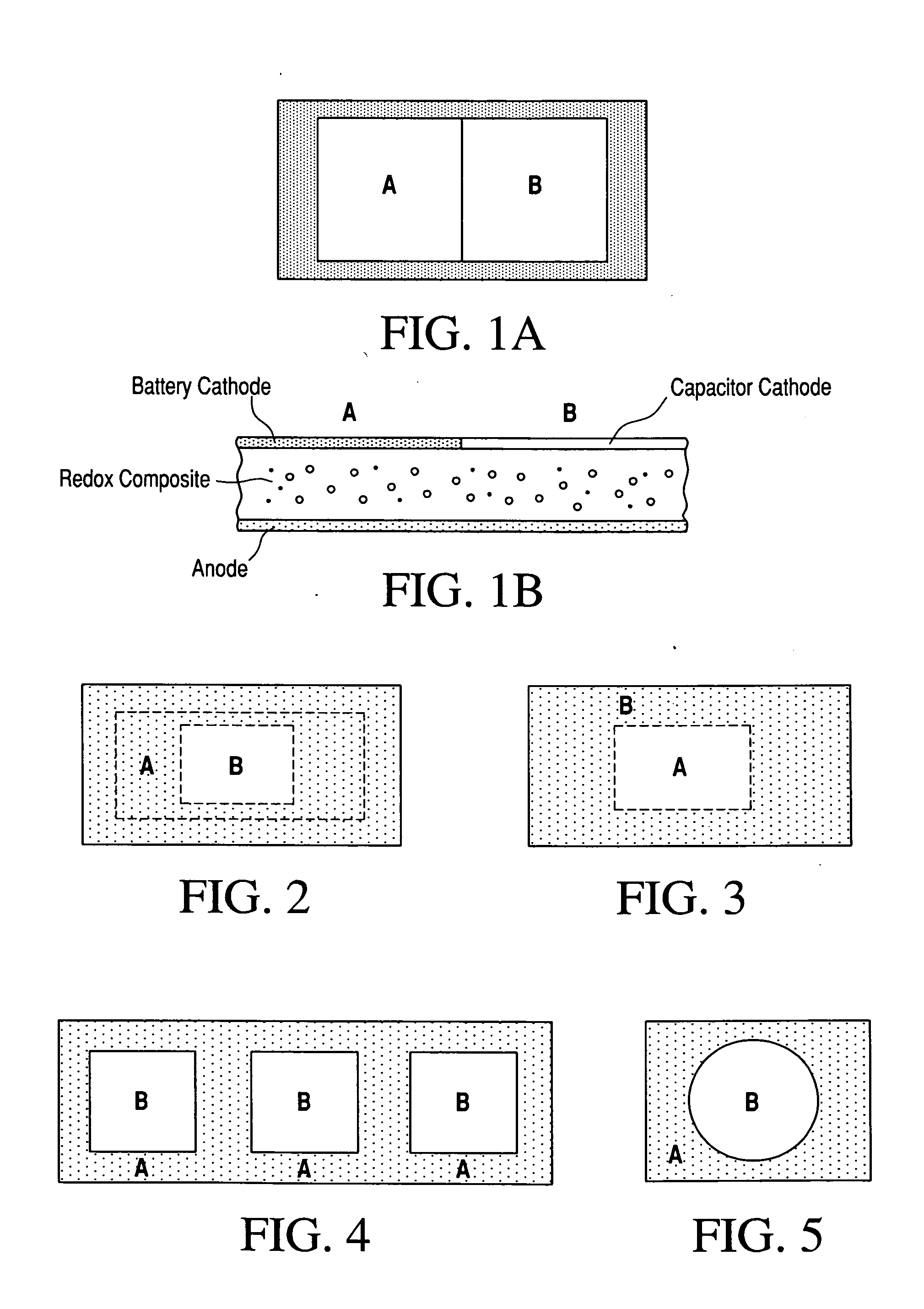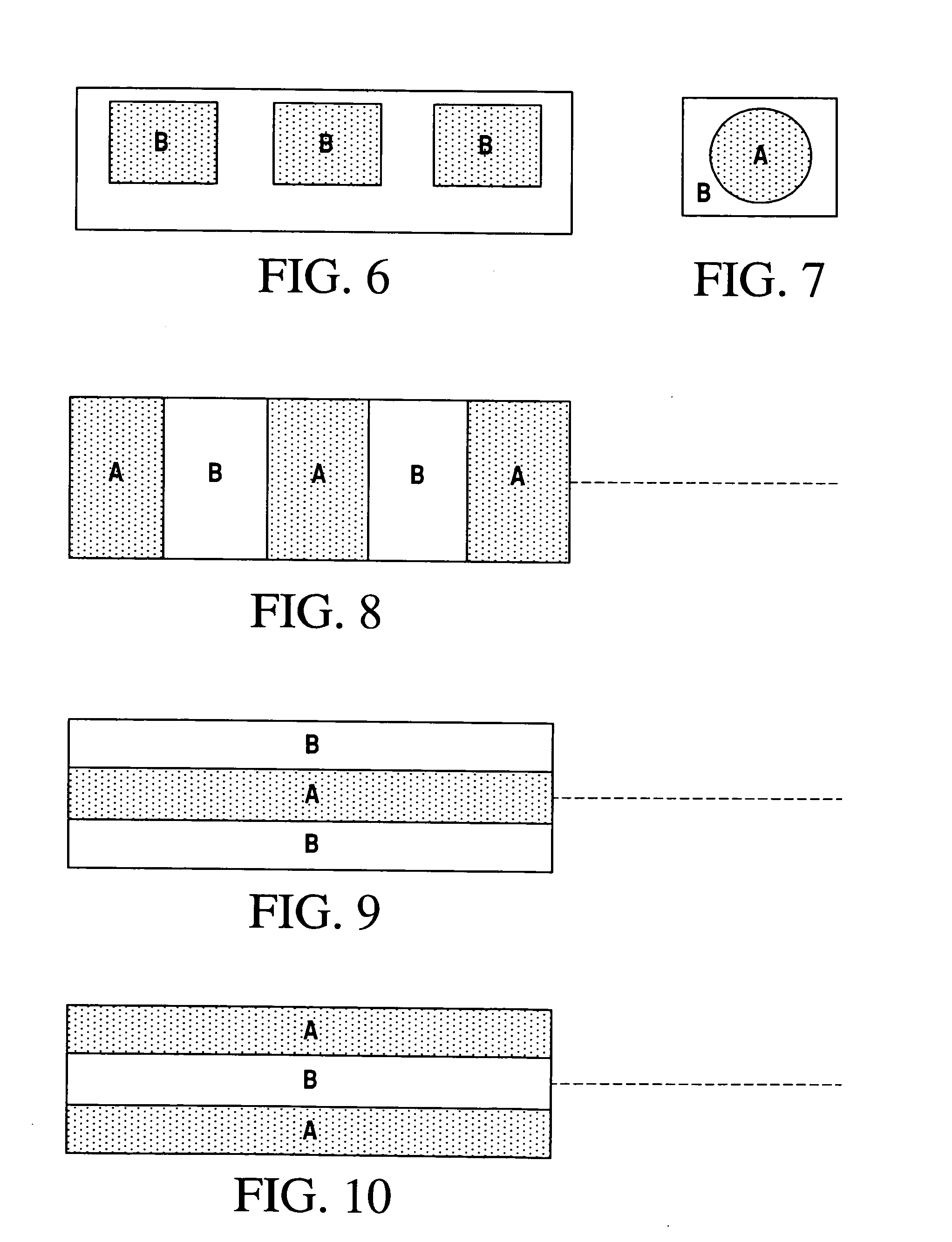Composite ionic conducting electrolytes
a technology of ionic conducting electrolytes and electrolyte, which is applied in the field of composite ionic conducting electrolytes, can solve the problems of limiting the selection factor of ionically conducting electrolyte, reducing the peak power output, and limited the peak operational voltage to which the device can be charged, so as to achieve greater volume of electrolyte and high voltage operational stability
- Summary
- Abstract
- Description
- Claims
- Application Information
AI Technical Summary
Benefits of technology
Problems solved by technology
Method used
Image
Examples
example p1
Li+ Conducting PVDF-HFP Polymer, MoO3 Composite Electrolyte Separator Membrane
[0079]2 gm. of PVDF-HFP reagent grade granules from Aldrich, MW: 400,000 g / mol are dissolved in 19 ml reagent grade DMF at 20° C. to produce a polymer solution. 10 gms of the polymer solution are mixed with 0.05 gm. MoO3 redox active particles that have an average size of 100 nm to form a blend.
[0080]The MoO3 particles are made by dissolving 0.8467 gms H2MoO4 in 2M ammonia solution to yield a 5 mM solution of H2MoO4. The pH of the solution is adjusted to a pH of 2-3 by dropwise addition of 4M HCl.
[0081]Additional 4M HCl is added under continuous stirring to form a white precipitate. The precipitate is collected by centrifuge and rinsed with absolute ethanol to form rinsed precipitate. Then, 0.8 gms of the rinsed precipitate is dispersed in 15 ml of absolute ethanol and heated at 150° C. for 8 hours to yield treated precipitate.
[0082]The treated precipitate is further washed with absolute ethanol and dried ...
example p2
Li+ Conducting PVDF-HFP Polymer, SnO2 Composite Electrolyte Separator Membrane
[0085]The procedure of example P1 is followed except that 0.05 gms of SnO2 is substituted for MoO3 to yield a membrane having thickness of 240 μm SnO2 is available from Aldrich.
example p3
Li+ Conducting PVDF-HFP Polymer, WO3 Composite Electrolyte Separator Membrane
[0086]2 gm. of PVDF-HFP reagent grade granules from Aldrich, MW: 400,000 g / mol are dissolved in 19 ml reagent grade DMF at 20° C. to enable formation of polymer solution. 10 gms of polymer solution are mixed with 0.05 gm. WO3 redox active particles that have an average size of 100 nm to form a blend.
[0087]The blend of redox active WO3 particle and polymer solution is ultrasonically vibrated for 20 min to enable formation of a treated blend. The treated blend is doctor bladed onto a glass substrate in order to form a cast membrane sheet. The cast membrane sheet is dried for 1 hour (ambient condition), contacted with absolute ethanol for 5 min, removed from the substrate, immersed in absolute ethanol for 16 hrs, vacuum dried at 20° C. and immersed in a Li+ conducting polymer solution formed by dissolving 0.46 gms LiPF6 in a 1:1 mixture by wt. of EC:DMC for 2 days.
PUM
| Property | Measurement | Unit |
|---|---|---|
| size | aaaaa | aaaaa |
| size | aaaaa | aaaaa |
| size | aaaaa | aaaaa |
Abstract
Description
Claims
Application Information
 Login to View More
Login to View More - R&D
- Intellectual Property
- Life Sciences
- Materials
- Tech Scout
- Unparalleled Data Quality
- Higher Quality Content
- 60% Fewer Hallucinations
Browse by: Latest US Patents, China's latest patents, Technical Efficacy Thesaurus, Application Domain, Technology Topic, Popular Technical Reports.
© 2025 PatSnap. All rights reserved.Legal|Privacy policy|Modern Slavery Act Transparency Statement|Sitemap|About US| Contact US: help@patsnap.com



